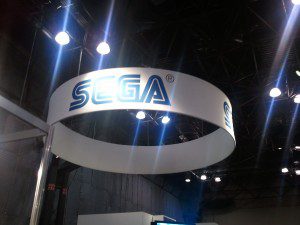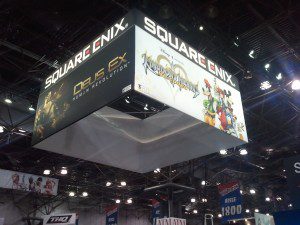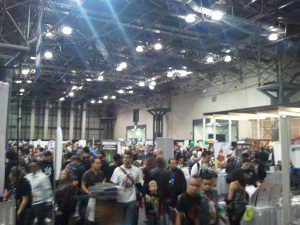 Sega took the chance at Comic Con to debut short animations and gameplay for their latest two movie Marvel acquisition games: Captain America: Super Soldier and Thor. Both were playing on several screens, with a large cluster of attendees crowded around aiming for a glimpse of what was to come. Attempting to play the game required a lot of patience, and the ability to withstand being smacked into on a regular basis. The same was the story at the Capcom booth, which was allowing attendees to sample the long-awaited “Marvel Vs. Capcom 3.” People were given one go around, usually about 5 minutes, to sample the game before being cycled to the back of the line to wait for their next turn. I applaud Capcom for doing their best to make sure that everybody got a turn, and applaud them more for taking time to craft a quality product: the one round I spent on the game impressed me, and I am not a fan of fighting games.
Sega took the chance at Comic Con to debut short animations and gameplay for their latest two movie Marvel acquisition games: Captain America: Super Soldier and Thor. Both were playing on several screens, with a large cluster of attendees crowded around aiming for a glimpse of what was to come. Attempting to play the game required a lot of patience, and the ability to withstand being smacked into on a regular basis. The same was the story at the Capcom booth, which was allowing attendees to sample the long-awaited “Marvel Vs. Capcom 3.” People were given one go around, usually about 5 minutes, to sample the game before being cycled to the back of the line to wait for their next turn. I applaud Capcom for doing their best to make sure that everybody got a turn, and applaud them more for taking time to craft a quality product: the one round I spent on the game impressed me, and I am not a fan of fighting games.
 Square, whom I previously stated had a huge display in the center of the entryway, was also showcasing new projects, including the latest in their wildly popular “Kingdom Hearts” franchise, “re:Coded”, and a number of machines dedicated to their new MMORPG “Final Fantasy XIV.” I also had a chance to sample the game, and found it a wonderful diversion to keep me busy before “Cataclysm” is released in December. They also were showing screens from some newer ventures, including Dungeon Siege 3, which looks to be very promising.
Square, whom I previously stated had a huge display in the center of the entryway, was also showcasing new projects, including the latest in their wildly popular “Kingdom Hearts” franchise, “re:Coded”, and a number of machines dedicated to their new MMORPG “Final Fantasy XIV.” I also had a chance to sample the game, and found it a wonderful diversion to keep me busy before “Cataclysm” is released in December. They also were showing screens from some newer ventures, including Dungeon Siege 3, which looks to be very promising.
In the back of the Expo floor, an enormous apparatus promoted the new, Blu-Ray and DVD release of the “Alien Anthology.” Attendees wee lining up to cram inside a small sleeper pod from the first film and watch the trailers and selected scenes from the upcoming, remastered releases of the sci-fi classics, while actors from the “Alien” and “Predator” movies, such as the star of “Predators,” Adrien Brody, signed autographs.
The back end of the main expo space, before the vendors took over, was home to a lot of smaller outfits, such as Wacom industries (who were showcasing a wonderful, new art tablet), an entire contingent of representatives introducing Chinese animation, various art schools and events, smaller game developers and a good deal of “cultural fare.” Also on prominent display was one of the major sponsors of the event, Midtown Comics, with a huge selection of books, shirts and toys.
If one has the chance to soldier on past the first half of the expo floor, they would find themselves inside the vast dealer’s space. Hundreds of vendors were crammed in tight there, all showcasing their various wares dedicated to comics, collectables, anime, art, clothing, and anything else they could possibly want. Now, it should be noted that this space was used for both Comic Con and Anime Fest: the only real division between the events were panel and artist spaces. So it was easy to find anime goods sandwiched between costumes and toys, across from “classic” comic book dealers and behind memorabilia outlets.
 Away from the almost choking atmosphere of the Comic Con, the artist alley was actually the most empty part of the con, within reason. The walkways were still full, but there was more space to move. Intel took over the entrance to show their newest processor and its applications for gaming. Behind Intel, Hasbro took the chance to allow gamers to sample their updated release of “Dungeons and Dragons: Return to Castle Ravenloft.” The entire side wall of the alley was taken up by guests signing autographs and posing for pictures. Huge lines appeared when James Marsters (Buffy the Vampire Slayer), Bruce Campbell (Evil Dead, Burn Notice), Katee Sackhoff (Battlestar Galactice) and J. Michael Straczynski (Babylon 5) made their appearances, and perennial favorite Lou Ferrigno (the Incredible Hulk) greeted fans for the entire weekend. Artists both prominent and amateur sat side by side, taking commissions and selling prints, books and other merchandise.
Away from the almost choking atmosphere of the Comic Con, the artist alley was actually the most empty part of the con, within reason. The walkways were still full, but there was more space to move. Intel took over the entrance to show their newest processor and its applications for gaming. Behind Intel, Hasbro took the chance to allow gamers to sample their updated release of “Dungeons and Dragons: Return to Castle Ravenloft.” The entire side wall of the alley was taken up by guests signing autographs and posing for pictures. Huge lines appeared when James Marsters (Buffy the Vampire Slayer), Bruce Campbell (Evil Dead, Burn Notice), Katee Sackhoff (Battlestar Galactice) and J. Michael Straczynski (Babylon 5) made their appearances, and perennial favorite Lou Ferrigno (the Incredible Hulk) greeted fans for the entire weekend. Artists both prominent and amateur sat side by side, taking commissions and selling prints, books and other merchandise.
Remember how I mentioned earlier that the anime section of the convention was tucked away into a corner? Well, heading down from the Comic Con Artist Alley, the sign proclaiming “This way to the NYAF Artist Alley” directed those attendees there for the anime programming to the end hall of the Javits, where the number of cosplayers skyrocketed, the booths were packed with artists doing commissions and selling work, people played games on a small stage, or lined up for one of 4 panel rooms with anime programming. It was all very segregated, and self-contained, so anyone who wished to avoid the massive Comic Con could do so very easily. But it was also very small, especially considering the other areas of the convention center. For perspective, consider the following: The entire NYAF section, panel rooms and all, could have fit into half of the comic con Artist Alley. The largest anime panel rooms were smaller than the “standard” comic con ones, and they filled up very quickly.
But, unlike the massive Expo floor, there was one thing there that set it apart: energy. Unlike the exercise in controlled chaos flowing above, the NYAF section was all laughs, cheers, meetups and community. I have written before how anime conventions foster a sense of community far beyond their multifandom counterparts, and this had lead to a skyrocketing number of new cons in the past decade. This year, more than any other, NYAF emphasized that sense and need for community.

